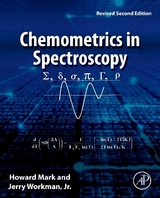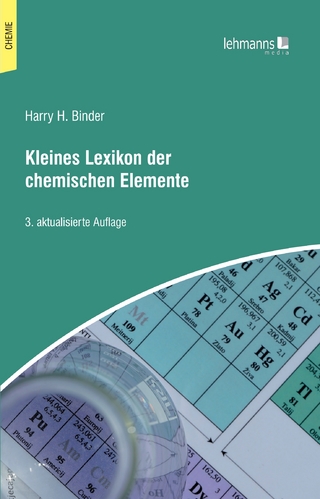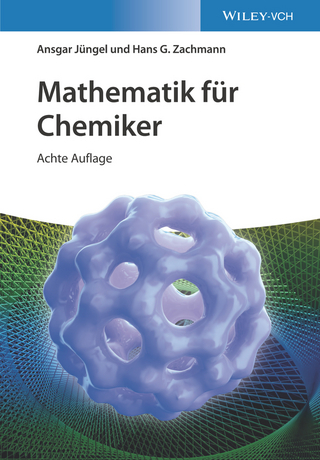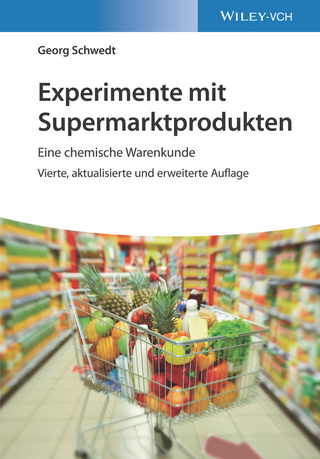
Chemometrics in Spectroscopy
Academic Press Inc (Verlag)
978-0-12-374024-3 (ISBN)
- Titel erscheint in neuer Auflage
- Artikel merken
Chemometrics in Spectroscopy builds upon the statistical information covered in other books written by these leading authors in the field by providing a broader range of mathematics and progressing into the fundamentals of multivariate and experimental data analysis. Subjects covered in this work include: matrix algebra, analytic geometry, experimental design, calibration regression, linearity, design of collaborative laboratory studies, comparing analytical methods, noise analysis, use of derivatives, analytical accuracy, analysis of variance, and much more are all part of this chemometrics compendium. Developed in the form of a tutorial offering a basic hands-on approach to chemometric and statistical analysis for analytical scientists, experimentalists, and spectroscopists. Without using complicated mathematics, Chemometrics in Spectroscopy demonstrates the basic principles underlying the use of common experimental, chemometric, and statistical tools. Emphasis has been given to problem-solving applications and the proper use and interpretation of data used for scientific research.
Howard Mark is President of Mark Electronics, Suffern, New York. He was previously affiliated as a Senior Scientist at Technicon Instrument Corp. in Tarrytown, New York. He holds a B.S. degree from City College of New York, an M.A. from City University of New York, and a PhD from New York University. His professional interests include instrument development, especially for spectroscopy; statistical and chemometric data analysis; and Custom software development, especially for implementation of data analysis algorithms. He received the 2003 Eastern Analytical Symposium Award for Achievement in Near Infrared Spectroscopy. He holds 6 U.S patents and has published 2 books and numerous book chapters. He has acted as Associate editor for the Handbook of Vibrational Spectroscopy, Wiley (2001). He has served as Past president of Council for Near-Infrared Spectroscopy (CNIRS), Treasurer of the New York section of the Society for Applied Spectroscopy, and as Past Chair of the New York section of the Society for Applied Spectroscopy. In addition he acts as Contributing editor and member of the Editorial Advisory Board of Spectroscopy. He has published over 150 peer-reviewed papers dealing with design and development of scientific instrumentation, new concepts in computerized instrumentation and data analysis. Jerome (Jerry) J. Workman, Jr. is Executive Vice President of Research & Engineering for Unity Scientific and Process Sensors Corporation; Certified Core Adjunct Professor at National University, CA; and Principal at Biotechnology Business Associates. He was formerly Vice President of Technology Research for Masimo Corporation; Director of Research, Technology & Applications Development for Molecular Spectroscopy & Microanalysis for ThermoFisher Scientific; Chief Technical Officer and Vice President of Research & Engineering at Argose Inc.; Senior Research Fellow at Kimberly-Clark Analytical Science & Technology; and Principal Scientist at Perkin-Elmer. Dr. Workman has played a major role in defining and developing over 20 scientific instrument advancements with novel software improvements for successful commercial use for start-ups to major corporations. He has more than 55 U.S. and international patent applications (since 1998); 20 U.S. and international patents issued, and multiple trade secrets. He has a total of 475 technical publications; and 18 reference books on a broad range of spectroscopy, chemometrics, and data processing techniques. He has received awards from the Eastern Analytical Symposium, ASTM International, Coblentz Society; as well as multiple fellowships, technical, and government appointments. He has taught annual courses in NIR spectroscopy, chemometrics, and statistics for the Association of Official Analytical Chemists, the American Chemical Society, the Instrument Society of America, and the Federation of Analytical Chemists and Spectroscopy Societies, and at several universities and corporations. He holds a BA degree cum laude in natural sciences, and an MA in biological sciences from Saint Mary's University of Minnesota, and a PhD degree with high commendation in biological chemistry from Columbia Pacific University. He is a graduate of the Columbia Senior Executive Program and also holds Columbia Business School Certificates in Executive Development (CIED) and in Business Excellence (CIBE). He also holds a Certificate in Strategy and Innovation from the M.I.T. Sloan School. He is listed in Who's Who in the World, Who's Who in America, and Who's Who in Science and Engineering.
1. A New Beginning 2. Elementary Matrix Algebra, Part 1 3. Elementary Matrix Algebra, Part 2 4. Matrix Algebra and Multiple Linear Regression, Part 1 5. Matrix Algebra and Multiple Linear Regression, Part 2 6. Matrix Algebra and Multiple Linear Regression, Part 3 7. Matrix Algebra and Multiple Linear Regression: Conclusion 8. Experimental Designs - Part 1 9. Experimental Designs - Part 2 10. Experimental Designs - Part 3 11. Analytic Geometry, Part I 12. Analytic Geometry, Part II 13. Analytic Geometry, Part III 14. Analytic Geometry, Part IV 15. Experimental Designs Part IV - Varying Parameters to Expand the Design 16. Experimental Designs Part V - One-at-a-time Designs 17. Experimental Designs Part VI - Sequential Designs 18. Experimental Designs Part VII, The Power of a Test 19. Experimental Designs Part VIII, The Power of a Test (Continued) 20. Experimental Designs Part IX - Sequential Designs Concluded 21. Calculating the Solution for Regression Techniques - Part I: Multivariate Regression Made Simple 22. Calculating the Solution for Regression Techniques - Part II: Principal Component(s) Regression Made Simple 23. Calculating the Solution for Regression Techniques - Part III: Partial Least Squares Regression Made Simple 24. Looking Ahead and Behind 25. A Simple Question 26. Calculating the Solution for Regression Techniques - Part IV: Singular Value Decomposition 27. Linearity in Calibration 28. Challenges: Unsolved Problems in Chemometrics 29. Linearity in Calibration - Act II Scene I 30. Linearity in Calibration - Act II Scene II 31. Linearity in Calibration - Act II Scene III 32. Linearity in Calibration - Act II Scene IV 33. Linearity in Calibration - Act II Scene V 34. A Blueprint for Collaborative Laboratory Studies 35. Using ANOVA for Collaborative Laboratory Studies, Part Two 36. Testing for Systematic Error in Collaborative Laboratory Studies, Part Three 37. Ranking Test for Collaborative Studies, Part Four 38. Efficient Comparison of Two Methods for Collaborative Laboratory Studies39. More About Collaborative Laboratory Studies, a Brief Recap and Additional Resources, Part Five 40. Is Noise Brought by the Stork?: Analysis of Noise, Part 1 41. Analysis of Noise, Part 2 42. Analysis of Noise, Part 3 43. Analysis of Noise, Part 4 44. Analysis of Noise, Part 5 45. Analysis of Noise, Part 6 46. Analysis of Noise, Part 7 47. Analysis of Noise, Part 8 48. Analysis of Noise, Part 9 49. Analysis of Noise, Part 10 50. Analysis of Noise, Part 11 51. Analysis of Noise, Part 12 52. Analysis of Noise, Part 13 53. Analysis of Noise, Part 14 54. Derivatives in Spectroscopy, Part 1: The Behaviour of Derivatives 55. Derivatives in Spectroscopy, Part 2: The True Derivative 56. Derivatives in Spectroscopy, Part 3: Computing the Derivative 57. Derivatives in Spectroscopy, Part 4: Calibrating with Derivatives 58. Comparison of Goodness of Fit Statistics, Part I 59. Comparison of Goodness of Fit Statistics, Part II 60. Comparison of Goodness of Fit Statistics, Part III 61. Comparison of Goodness of Fit Statistics, Part IV 62. Derivatives in Spectroscopy - Update 63. Linearity in Calibration, Act III, Scene I: The Importance of Non-Linearity 64. Linearity in Calibration, Act III, Scene II: The Durbin-Watson Statistic 65. Linearity in Calibration, Act III, Scene III: Other Tests for Non-Linearity 66. Linearity in Calibration, Act III Scene IV: How To Test For non-Linearity 67. Linearity in Calibration, Act III Scene V: Quantifying Non-linearity 68. Linearity in Calibration, Act III Scene VI: Quantifying Non-linearity, Part II, and a News Flash 69. Connecting Chemometrics to Statistics - Part 1, the Chemometrics Side 70. Connecting Chemometrics to Statistics - Part 2, the Statistics Side 71. Limitations in Analytical Accuracy – Part 1 72. Limitations in Analytical Accuracy – Part 2 73. Limitations in Analytical Accuracy – Part 3 74. The Statistics of Spectral Searches 75. The Chemometrics of Imaging Spectroscopy
| Erscheint lt. Verlag | 12.9.2007 |
|---|---|
| Verlagsort | San Diego |
| Sprache | englisch |
| Gewicht | 1160 g |
| Themenwelt | Naturwissenschaften ► Chemie ► Allgemeines / Lexika |
| Naturwissenschaften ► Chemie ► Analytische Chemie | |
| ISBN-10 | 0-12-374024-X / 012374024X |
| ISBN-13 | 978-0-12-374024-3 / 9780123740243 |
| Zustand | Neuware |
| Informationen gemäß Produktsicherheitsverordnung (GPSR) | |
| Haben Sie eine Frage zum Produkt? |
aus dem Bereich



